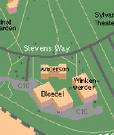Nut Pine Tree Information
Images of Nut Pine:






Nut Pine grows in the following 2 states and provinces:
California, HawaiiInformation about Nut Pine:
The Pinus Coulteri is commonly known as the Big-cone Pine, California Coulter Pine, Coulter Pine, Nut Pine as well as Pitch Pine.
The currently accepted scientific name of Coulter pine is Pinus coulteri D. Don . There are no recognized subspecies or varieties. Coulter pine hybridizes with Jeffrey pine (Pinus jeffreyi) .Coulter pine occurs from Contra Costa County, California, south through the Coastal, Transverse, and Peninsular ranges to the Mexican border . It is cultivated in Hawaii .Coulter pine occurs in a variety of plant associations, but seldom forms extensive pure stands . Where they do occur, communities dominated by Coulter pine intergrade with chaparral and lower montane coniferous forest . Coulter pine is named as a dominant species in the following published classifications: Terrestrial natural communities of California Vegetation types of the San Bernadino Mountains Vegetation of the San Bernadino Mountains A vegetation classification system applied to southern California Mixed evergreen forest Vascular plant communities of California Montane and subalpine forests of the Transverse and Peninsular ranges An introduction to the plant communities of the Santa Ana and San Jacinto Mountains Associated trees not mentioned in Distribution and Occurrence include sugar pine (Pinus lambertiana), bristlecone fir (Abies bracteata), incense-cedar (Libocedrus decurrens), Sargent cypress (Cupressus sargentii), black cottonwood (Populus trichocarpa), California bay (Umbellularia californica), bigcone Douglas-fir (Pseudotsuga macrocarpa), Pacific madrone (Arbutus menziesii), and birchleaf mountain-mahogany (Cercocarpus betuloides var. betuloides) . Understory associates include chamise (Adenostoma fasciculatum), Eastwood manzanita (Arctostaphylos glandulosa), Pringle manzanita (A. pringlei), pointleaf manzanita (A. pugens), deerbrush (Ceanothus integerrimus), annual hairgrass (Deschampsia danthonioides), rareflower heterocodon (Heterocodon rariflorum), golden violet (Viola douglasii), and annual ryegrass (Lolium multiflorum) .Some of the information provided here is attributed to:Cope, Amy B. 1993. Pinus coulteri. In: Fire Effects Information System, [Online]. U.S. Department of Agriculture, Forest Service, Rocky Mountain Research Station, Fire Sciences Laboratory (Producer). , available at the USDA Fire Effects Information System (FEIS) website